- 1. Why Wallpaper for Hallways and Entryways?
- 2. What wallpaper to choose: the types, their advantages and disadvantages
- 3. Combining wallpaper in the hallway
- 4. What color combination is better: dark and light wallpaper in the hallway
- 5. Wallpaper for dark and light doors
- 6. How to choose wallpaper for a small and narrow hallway
- 7. How to paste wallpaper in the hallway: step by step tips
- 8. Shortly about the main thing: how to choose wallpaper in the hallway
- 9. Wallpaper for hallways and entrance halls: photos and ideas
The hallway is where your new guests get their first impression of your home’s affluence, taste, and hospitality. In this case, even the budget wallpaper can make this area stylish and cozy. Let’s figure out together what wallpaper is right for you and how to choose it.

Why Wallpaper for Hallways and Entryways?
Highlight the 5 advantages of using wallpaper in the hallway.

- The choice of colors and prints of wallpaper is huge. By combining fabrics of different shades, or wallpaper and other finishing materials, it is easy to zone the area of the hallway and living room.
- Wallpaper does not take away valuable centimeters of space in a narrow corridor. And at the same time can visually expand the walls, if properly combined colors.
- Dense textured wallpaper will hide minor defects in the walls of an old house.
- Wallpaper canvases are easy to paste and can be quickly replaced if necessary.
- Among the variety of wallpaper materials, you can choose a universal one for yourself – one that is quick to clean, fits the general style of the home, and will retain its aesthetic qualities for a long time.
- Quality photo wallpaper on the wall can significantly refresh your interior without serious financial investment.
Let’s talk about the choice of canvases in more detail.
What wallpaper to choose: the types, their advantages and disadvantages
Paper wallpaper in the hallway – this is, of course, already a classic.

However, there are newer varieties of such cloths, stylish, practical, just for the corridor – for example, two-layer, foil-finished cloths.

Advantages of all paper wallpapers
- Very large color palette (compared to more exotic)
- Availability of choice: the desired color can be found among canvases of any price category
- Eco-friendliness
Disadvantages
Paper wallpaper, even double-layered, loses out to other fabrics in terms of durability.
Conclusion
Opt for paper wallpaper is useful if you plan to update the interior hallway no later than 5-7 years.
Textile wallpaper
Textile wallpaper is the marker of a chic hallway in oriental, palatial or classic style.

Their main advantage
If you choose the right colors and accents, you can create a cozy, interesting environment with the help of fabric wallpaper.
Disadvantages
- Textile wallpaper is the least practical and therefore least suitable for the corridor. After all, fabrics attract dust, quickly burn out and wear out.
- At the same time, such cloths belong to the expensive segment.
Conclusion
Textile wallpaper is worth buying if this is required by the style and if you intend to update the environment within a short time.
Vinyl wallpaper
Vinyl wallpaper is the most practical of the newest types of wallpaper.
This is a dense cloth, which is designed primarily for passable rooms – corridors and hallways.

The top layer of this wallpaper – PVC, or vinyl – is not scratched, not damaged and retains its original appearance for a long time. Their basis can be paper or fleece.
Advantages of vinyl wallpaper
- Vinyl wallpaper is washable (!)
- They have a long service life – up to 20 years
- This wallpaper has the largest choice of textures: there are smooth models, embossed, foamed, with the texture of the plaster
- At the same time their texture is dense and hide small flaws on the walls
- Separately, it is worth mentioning about the structural vinyl wallpaper on a fleece base: they can be repeatedly repainted, preserving the pattern of relief
- When pasting cloths with a fleece backing, it is enough to dab the wall with glue
The disadvantage of this wallpaper
It is one. The vinyl layer does not allow air to pass through and emits a dangerous substance – formaldehyde. For this reason, they are recommended only for nonresidential rooms and corridors.
This disadvantage is partially eliminated in fabrics with a porous, “foam” surface. They are safer.

Conclusion
Canvases with vinyl coating are versatile, but not eco-friendly. You can use them without harm to health, but only in two cases:
- If the room of the hallway is well ventilated
- or if the wallpaper itself has an advanced porous structure.
Fleece wallpaper
It is also possible to distinguish the fleece wallpaper. They include both cloths with a fleece backing and vinyl coating, and homogeneous fleece.
Their advantages
- These canvases have the same advantages as vinyl: they hide flaws in the walls, can be used for painting
- In addition, fleece has a pleasant velvety texture, which resembles textile wallpaper
- Fleece wallpaper without a vinyl layer is environmentally friendly (!).
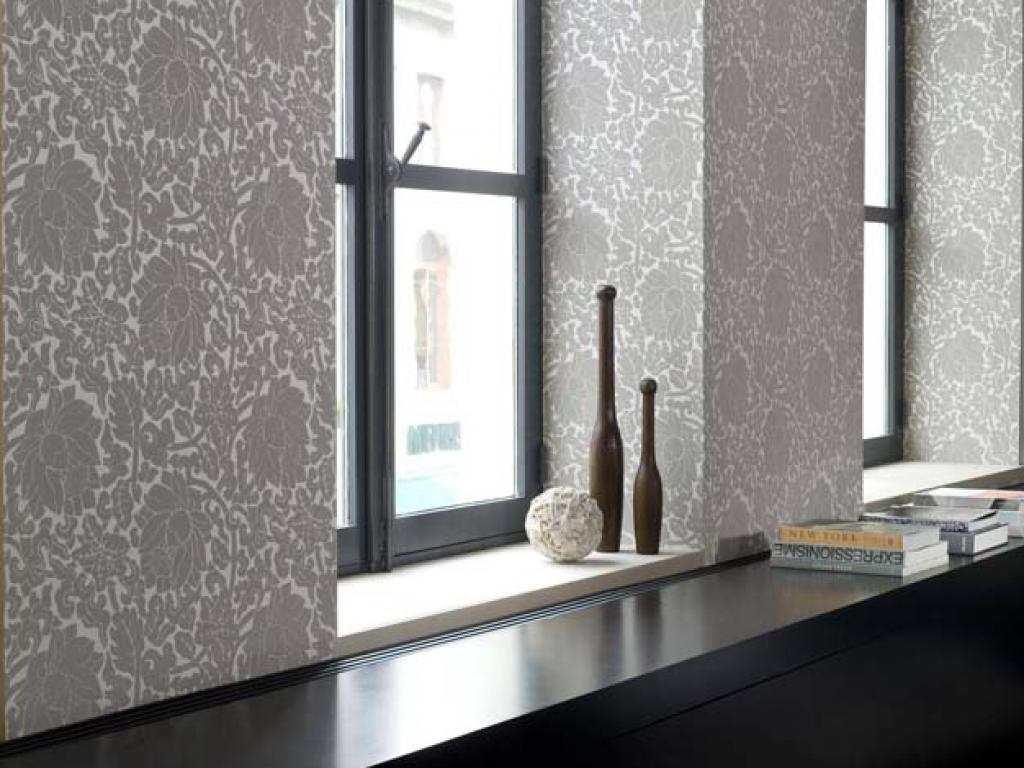
Disadvantage
The only disadvantage of fleece wallpaper – high cost in comparison with the above types of fabrics.
And if you are looking for high-end material – let’s compare them with other fashionable wallpaper modifications.
Photo wallpaper
Photo wallpaper. This is a separate extensive group of wallpapers made of different materials. They can be paper, fabric, vinyl, and with a non-woven base. The main difference of photo wallpapers is that they are usually large-format and have a bright picture with photographic quality.

The service life, thickness, and performance of photo wallpapers depend on the material from which they are made. Let’s tell in detail about their aesthetic features.
Advantages
- Photo wallpaper can add paint to the interior or become a highlight of the hallway: it depends on how much of the wall is covered with wallpaper
- Large-format wallpaper looks like a whole picture
- Depending on the size of the main pattern, photo wallpaper can add depth to the interior, expand the walls, correct the size of a narrow hallway
- Photo wallpaper can be matched to any interior style, especially romantic, youth and even loft.

For comparison, let’s break down two other groups of wallpaper, which are always produced without prints.
Liquid wallpaper
Liquid wallpaper (silk decorative plaster) is a mixture for finishing walls. They are applied to the walls, as conventional plaster, but have more environmentally friendly fillers. Their composition may include:
- natural fibers – cellulose or cotton (the main binding component that distinguishes wallpaper from sandy plaster mix)
- pigments
- in some models – silk threads
- and even marble chips.

Advantages of liquid wallpaper
- Such compositions hide noticeable flaws on the walls, and are easy to apply to hard-to-reach areas
- Natural mixtures “breathe” and do not emit toxic substances
- Liquid wallpaper does not wear out for a long time. The painted layer is easily repaired
- They can be easily cleaned with a standard cloth or a vacuum cleaner
- Wallpaper with the addition of marble chips form an interesting textured surface. At the same time they are especially reliable and durable
- Using 2 or more types of wallpaper and a stencil, you can create an interesting drawing on the wall.

Disadvantages
A significant disadvantage of liquid wallpaper is only that after application, it takes a long time to dry (from 2 to 5 days). In addition, when finishing the hallway, it is necessary to use an additional coating to protect against moisture – a primer or acrylic varnish.
Natural wallpaper
Natural wallpaper. In this separate group we will allocate wallpaper made of natural wood materials.

The most popular of the exotic natural wallpapers are cork and bamboo. There are also more interesting modifications – of palm leaves, jute.
Advantages of any natural wallpaper
- All have natural colors (eco interior marker)
- Interesting textures, ideal for Japanese and any ethnic interior styles
- Cork and bamboo wallpaper does not burn out, not damaged by fungus, even in damp rooms
Disadvantage
One disadvantage is that natural wallpaper has a minimal choice of colors.
However, bamboo does have different shades, depending on the country of growth – brown, red, gold. At the same time, all natural wood tones are pleasing to the eye.
Conclusion
Consider natural wallpaper is worthwhile if you are going to decorate the interior in eco-style, ethnic Japanese, oriental or tropical.
Combining wallpaper in the hallway
In order to elegantly divide the corridor into zones and to solve many other design problems, the technique of combining different types of wallpaper is used.
Combining light and dark wallpaper, monochrome and prints, it is possible to correct flaws in the layout, “raise” the ceiling, and place accents. In this case, the interior of the corridor usually looks richer.

Well combined, in particular:
- different types of paper cloths, such as monochrome and photo wallpaper
- paper and vinyl wallpaper
- liquid and thick textured wallpaper (vinyl or vinyl or non-woven)
- bamboo wallpaper can be combined with any monochrome textured fabrics, photo wallpaper in eco-style.
Usually elegantly combined two types of wallpaper. In this case, such combinations are acceptable:
- The use of two tones of the same color scheme, solid colors and prints

- Companion colors also look harmonious and gentle together
- The combination of two types of wallpaper with contrasting colors and similar textures looks stylish.
It is possible to successfully combine and three matching colors of wallpaper in the hallway (but no more). This requires more design knowledge and a sense of taste.

You can combine colors in different ways. Let’s talk about the main types of combination.
Horizontal zoning

Horizontal lines visually lengthen the walls, but make the room lower. Therefore, such a technique can be used in hallways with high ceilings. In this case, it is better that the bottom was finished with practical wear-resistant wallpaper – cork, bamboo, liquid wallpaper.
Zoning looks harmonious, if the additional color is highlighted about 1/3 of the wall above or below. If the corridor is very high, you can use another method – on a single-colored wall to make one or two stripes of printed wallpaper.
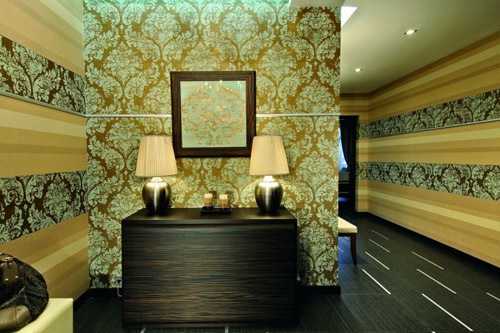
Vertical zoning
In this case, an additional color or print is present in separate stripes. Thanks to this method, it is possible to highlight conditional zones in the hallway and make the room higher.

Accent Wall
One wall can be different in color from the others. Despite the fact that the accent wall is usually darker, thanks to this method, the corridor room is harmoniously stretched.

Wallpaper inserts or patchwork
This technique implies that all walls are decorated with one color, and panels or patches of photo wallpaper, printed or contrasting canvases are used.

What color combination is better: dark and light wallpaper in the hallway
Different interior styles have tips for choosing the perfect color combinations.
For example, different variations of combinations of brown, beige, burgundy, blue, and horizontal wall zoning are typical for classics.
The hallway can contain one background natural color in the Provence style – beige, blue, lavender, pistachio or light gray, in different shades, on wallpaper with a floral print and on monochrome.
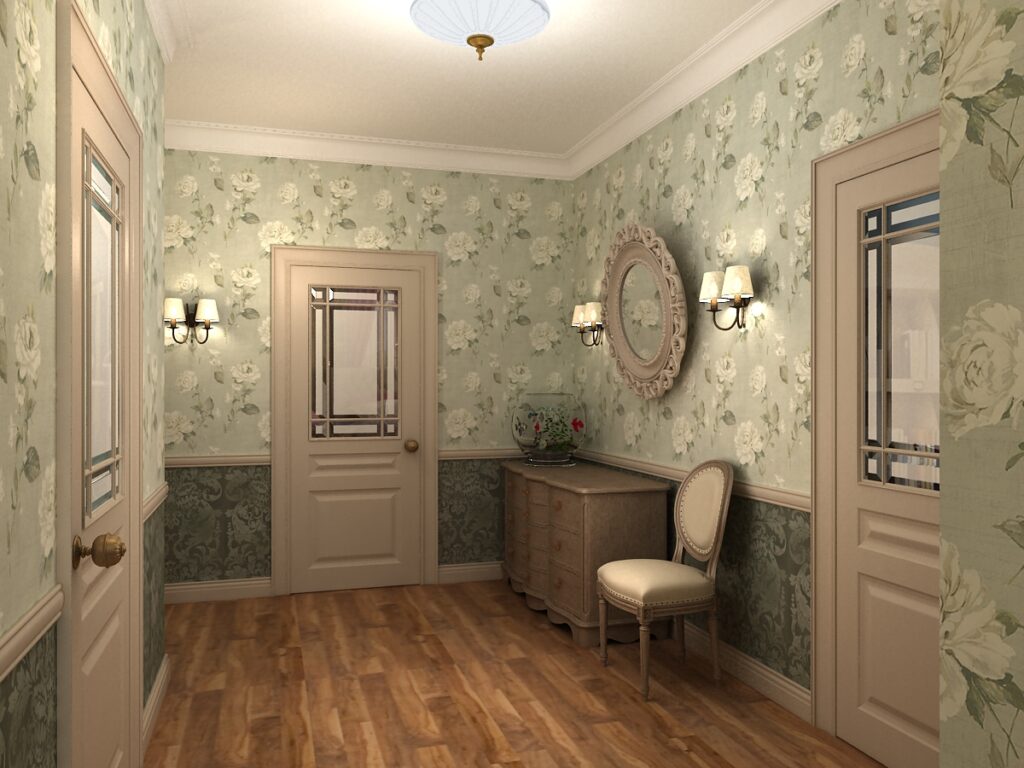
Modern styles close to minimalism include contrasting combinations of monochrome wallpaper: white with black, blue, etc. In this case, it is better to decorate the accent wall with a darker color.

There are a lot of options. But let’s add that the main color of wallpaper in the hallway must, ideally, be in harmony with the furnishings and especially with the color of the doors. How – let’s consider in detail.
Wallpaper for dark and light doors
Traditional entrance doors – dark wood or black – go well with any wallpaper in light pastel colors – beige, gray, blue. Such a classic combination will always win.

Brown doors also look harmonious against the background of bright red, pink, orange walls or liquid brick wallpaper.

In general, dark-colored doors are universal, they can become an element of the interior in the loft, classic, retro style.
At the same time, to the light doors, the wallpaper should be chosen more carefully, with the use of design tricks.
If next to such doors is light wallpaper, the combination looks gentle. But the color of the walls and doors should differ by at least a tone.
Shades of bleached oak, ash in the door panels will be combined with wallpaper of these types:
- yellow-brown
- burgundy
- purple
- pink
- milky
- mustard.

The wall with the door can be much darker than the door leaf. But in this case, the color in which the door is made must be present on the opposite wall or on other walls in separate accents (on vertical wallpaper strips, long panels).
How to choose wallpaper for a small and narrow hallway
If you have a miniature windowless hallway at your disposal – you are, of course, limited in the choice of wallpaper colors and patterns. However, even a compact hallway of an old house can be made cozy and elegant.
Let’s find out what design tricks are used when working with hallways with an area of 27 to 43 sq. ft. (2.5 to 4 sq. ), disproportionate and narrow, typical for old Soviet houses.
The main thing to consider is that in this case, the background dark color is absolutely inappropriate. It will create in a small room inappropriate chamber atmosphere.
In addition, usually in a small corridor are undesirable classic monogram patterns, other large and bright designs. Such elements can be used only in accents, if enough design knowledge.
In order to make such a hallway cozy, it is worth choosing wallpaper in light colors. And if the room does not have enough sunlight – it is better that the shades of cloths were warm, pastel. Suitable, in particular, are the following colors:
- beige
- cream
- the color of melted milk
- sandy
- light blue
- light pink
- universal gray shades – light smoky, gray-blue, gray-salad

In addition, if the hallway is cramped and disproportionate, it is useful to use new ideas designers in the choice of wallpaper.
Contrast technique
One of the walls can be decorated with a dark color to visually make the area narrow corridor more harmonious.
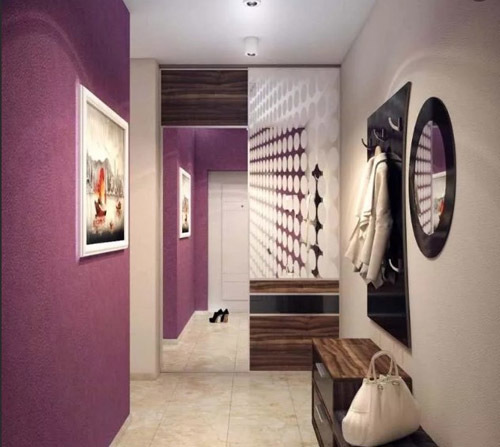
Small prints
Wallpaper with an inconspicuous small print can be used for all walls of a compact hallway. Another option – on the accent wall can be a bright print.
The French provincial style welcomes maximum lightened walls with a small floral print.

Minimalism
This style is suitable for very compact corridors. In order to decorate the interior of the hallway in the style of minimalism, you need to carefully choose two or three main solid colors. This can be a black-white-red retro combination, a combination of beige and brown.
One of the style options – Japanese minimalism – allows a combination of dark wood and white wallpaper.

Vertical stripes
They will add to the interior a note of English aristocracy, visually “raise” the room.
However, the lines should not “dazzle”. It is better that they were moderately bright, harmonious width.

Zoning a long hallway
With the help of vertical strips of different colors, you can conditionally divide a narrow hallway into zones and at the same time visually increase the space. In this case, the contrasting stripes should be quite wide, made of monochrome or textured bamboo wallpaper.

Photo wallpaper with perspective
In a small hallway can use photo wallpaper, but their choice in this case should be particularly careful and thoughtful. Volumetric landscape picture will overload the compact interior.
Ideally, it is better to use a simple photo picture, which will add depth and will be combined with the elements of furniture.
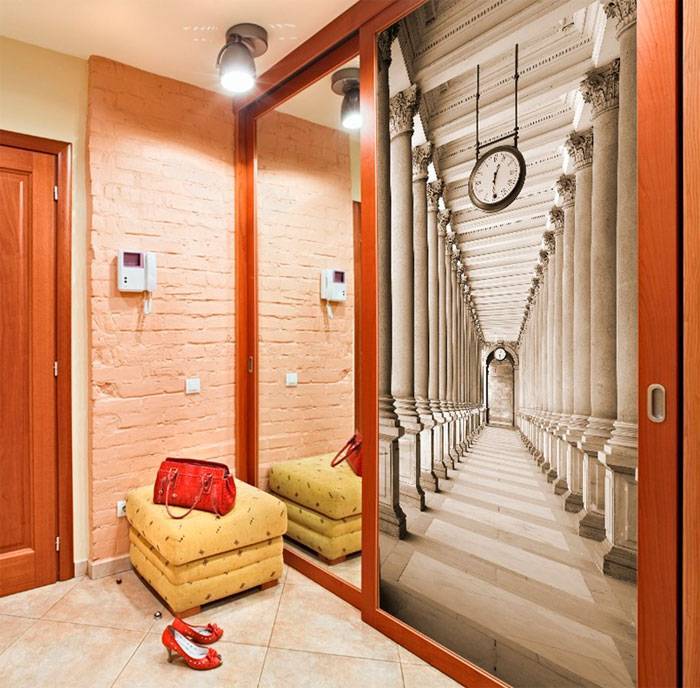
How to paste wallpaper in the hallway: step by step tips
- Before you begin, be sure to remove old wallpaper (if any), thoroughly clean and prime the walls.
- Be sure to learn how to mount the wallpaper selected types. The easiest thing is usually to work with vinyl and fleeceelin modifications. For gluing such canvases, it is usually enough only to lubricate the wall with glue. Regarding the use of exotic wallpaper is better to consult even before buying.
- Start wallpapering walls is usually preferable from the door or a large element of the furnishings, which immediately catches the eye – the window, aisle. An exception to this rule – dense vinyl wallpaper (they can be glued from the corner).
- Dense embossed wallpaper should be glued exactly butt to butt. Paper cloths should slightly overlap each other.
- The first band should be glued especially carefully, strictly vertically. Most often for accuracy is to use a level or plumb line.
- The following strips are better to glue in a clockwise direction.
- When combining two or three types of wallpaper, it is necessary to think in advance about the design project and make a marking in the places of docking.
- If a horizontal division of the wall is used, the wallpaper is glued in the traditional vertical way. First it is recommended to make the upper strip. The joint line can be decorated with moldings, slats or, if the thickness of the panels is the same, a paper border. If the canvases are dense, the molding can be attached butt-jointed with them.
- Inserts or flaps of another type of wallpaper are glued on top of the main wallpaper or butted together. Such elements can also be decorated with moldings and slats.
- When using moldings, the strips themselves are most often attached first and then the wallpaper is glued.
Trim the cloth near the moldings or battens, using a thick spatula and a box cutter.
Shortly about the main thing: how to choose wallpaper in the hallway
So, when choosing wallpaper for the hallway, you can be guided by different criteria.
- If you appreciate eco-friendly solutions, naturalness, assess the design projects of corridors with wallpaper made of paper, cork, bamboo and choose your type of canvas.
- Paper canvases also win over any other in terms of price.
- If durability and ease of working with materials is more important to you than price, compare the advantages of vinyl, fleece and liquid wallpaper.
When choosing a wallpaper design, pay attention to the colors and prints that will visually transform the layout. For example, if the corridor room is small, narrow and dark, pay attention to such wallpaper designs:
- Monochrome, in pastel colors
- Simple unbroken print
- Vertical lines
- Pictures that add depth to the space
- Or any universal geometric pattern that will combine with any piece of furniture.
Use ready-made elegant ideas that allow you to decorate even a simple corridor chic and tasteful.
Wallpaper for hallways and entrance halls: photos and ideas


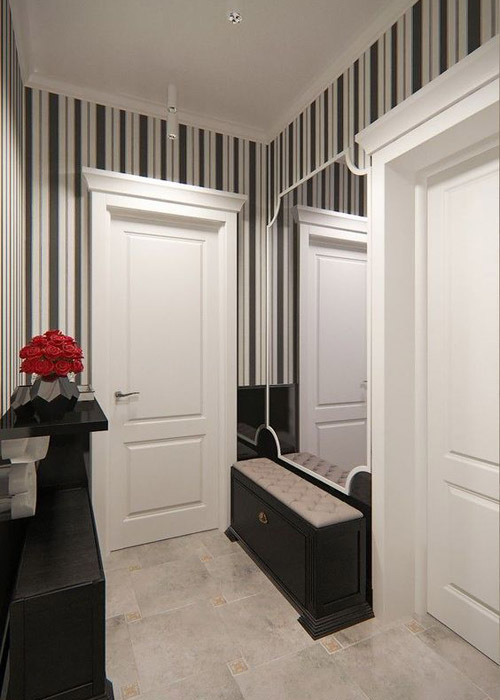
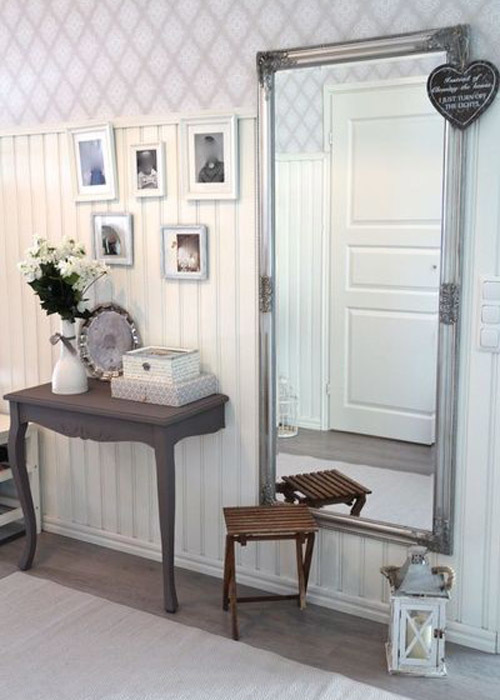
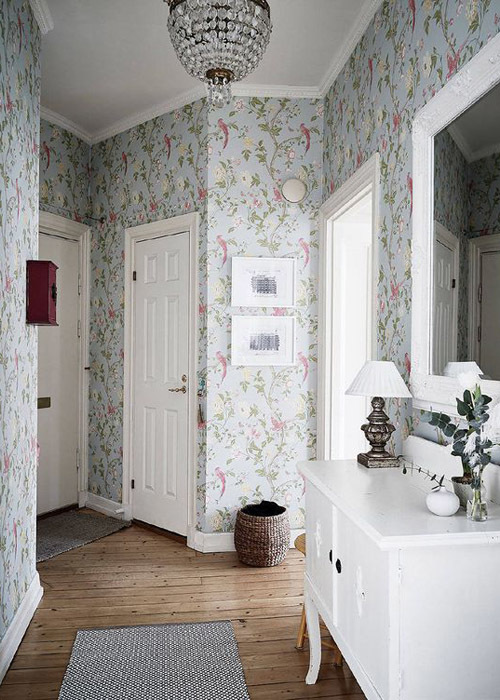














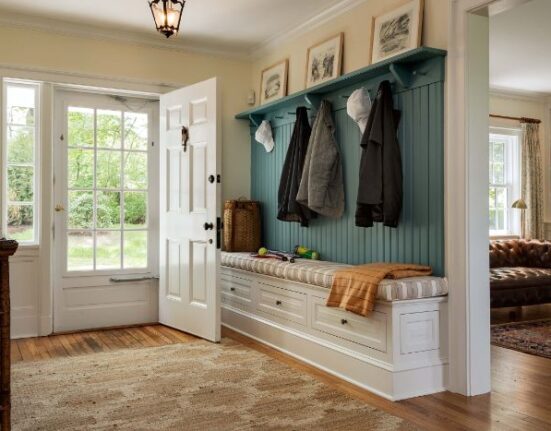
Leave feedback about this